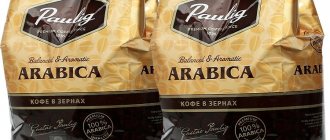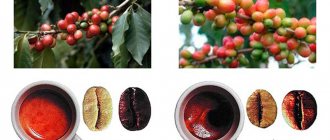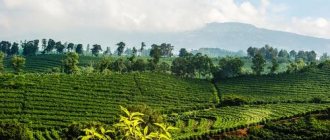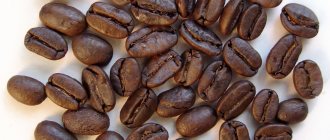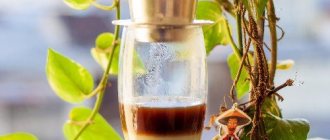General information about Arabica
Arabica is a coffee tree from the genus of evergreen plants.
This is a high-yielding tree. The main feature of its fruits is its relatively low caffeine content. Thus, a drink made from them has a gentler effect on the human body.
The plant was first described by the Swedish scientist Carl Lineus. Much later, genetic studies revealed that this type of coffee tree is a hybrid. It differs from other varieties by the presence of four chromosomes instead of two.
A genetic mutation largely determined the taste of the berries.
Origin story
Arabica arabica (Coffea Arabica) is the result of a natural crossing of two types of coffee trees: Eugenioides and Robusta. The plants grew close together, which allowed pollen from one to fall into the flowers of the other. It is believed that this happened in Ethiopia.
The mother plant was Eugenioides, and the father plant was Robusta. Their offspring became the basis for the emergence of a new species. Around the 9th century. Coffee berries became popular among warriors, shepherds and monks who operated in Ethiopia. Later the Arabs tried them. They contributed to the spread of this Arabic type of coffee.
Where does the coffee tree grow?
The natural habitat for Arabica is the vast area between Sudan, Ethiopia and Kenya. Wild coffee trees are unpretentious and are often found in mountainous areas at altitudes from 600 to 2500 m above sea level. The optimal temperature for this plant is between 15 and 25°C. Human activity has led to the spread of this type of coffee tree. Now it is grown in many countries of the equatorial belt, including:
- Venezuela.
- Salvador.
- Costa Rica.
- Cuba.
- Peru.
- Bolivia.
- Brazil.
- Colombia.
- Uganda.
- Haiti.
- Zambia.
- Rwanda.
- Tanzania, etc.
External description: flowers, fruits and seeds
This is an evergreen tree that grows up to 10 m. However, to obtain fruit it is pruned, forming a dense crown not exceeding 2 m in height. This makes the process of picking berries easier. The lifespan of the plant is 50-60 years. It bears fruit most intensively during the first 15 years. Subsequently, the number of berries decreases. Arabica flowers bloom throughout the year. On one tree you can find not only open buds, but also green and already ripe fruits.
Arabica fruits ripen 6-7 months after flowering.
The leaves of the coffee tree have an oval-elongated shape. White flowers are located on both skeletal and peripheral branches. They appear in bunches of 5-8 pieces. Only a few of them are pollinated and form an ovary. The flowering period lasts about 2-3 days.
The formation and ripening of fruits takes about 9 months. Ripe berries acquire a red tint and a glossy shine. The pulp becomes juicy and sweet, attracting birds and animals that can become seed carriers. The stone located inside is bicotyledonous. In its raw form, it has a green-brown color.
Compound
Arabica beans have relatively low caffeine content, reaching 1-1.5%. At the same time, the level of beneficial essential oils is 18%, and sugar up to 8%.
In addition, the product contains a lot of plant fiber.
The history of the birth of Arabica coffee
70% of all coffee consumed annually is Arabica.
The origin of Arabica dates back to 1000 BC, in the highland kingdom of Kefa, in the southwest of modern Ethiopia. The beans were ground, mixed with fat into balls the size of ping pong balls, and chewed. In the homeland of Arabica, Ethiopia, wild coffee trees still grow.
Around the 7th century, the grains crossed the Red Sea into what is now Yemen and lower Arabia. The first written record of coffee made from roasted coffee beans comes from Arab scholars who wrote that the drink helped them extend their working hours.
The Arab discovery of making a brew from roasted beans first spread among the Egyptians and Turks, and then throughout the world. The grains got their name from the country in which they were first used to make a drink – Arabica, Arabica.
Features of cultivation
This type of coffee tree is unpretentious, but the best yield is achieved in mountain valleys, where high humidity and temperature remain throughout the year. Under such conditions, it is possible to obtain up to 4 grain harvests per year. In addition, the chemical composition of the soil suitable for this plant has a positive effect on fruiting.
The flavor of the beans varies depending on which region they come from. When grown on poor soils in arid conditions, where a short-term temperature drop below 15°C is possible, it is possible to obtain a harvest once a year. On average, one tree produces from 2 to 5 kg of berries.
Nowadays coffee is grown on extensive plantations. Gentle hillsides are often cultivated for this tree. The plant requires systematic pruning to prevent excessive branch spread. The berries are picked manually.
Differences between Arabica and Robusta
Arabica coffee differs from Robusta in appearance, taste and aroma:
- Arabica has oblong grains, Robusta has smaller and almost round beans;
- the “groove” located on the flat side of the Arabica grain is sinuous, similar to the Latin letter S, in Robusta it is more straight;
- Arabica contains 1–1.5% caffeine, Robusta – up to 3%;
- Arabica beans have a delicate, rich aroma (contain up to 18% essential oils), Robusta contains only 8% essential oils, its smell is less expressive;
- Arabica has a rich, rich taste, which has a specific sourness; Robusta has a very bitter aftertaste;
- Robusta is cheaper than most Arabica varieties.
Robusta is often added to Arabica blends. If there is no more than 10% robusta, this only benefits the mixture: robusta gives the coffee strength, slightly enhances the piquant bitterness and promotes the formation of a dense foam. But blends with a higher robusta content are too bitter, so they are mainly used for making coffee with milk.
Blends with 10% robusta content are good for brewing coffee in coffee makers and coffee machines. Turkish coffee is usually prepared from pure Arabica (one variety or a mixture of several).
Taste characteristics
Unlike other varieties of coffee, the berries of this plant, after processing, produce a drink with a slight sourness. Bitterness is weakly expressed. This is due to the low caffeine content.
Factors affecting taste
First of all, the composition of the soil and the climatic conditions in which the tree grew are important.
The taste of coffee depends on where the Arabica grows.
In addition, the method of collection and primary processing affects the quality. Ground coffee is less resistant to transportation than grain coffee. The taste of the product is also influenced by proper storage.
How to store Arabica coffee beans
Unroasted coffee beans can be stored for one to three years in an airtight container. The grain can be stored for up to a year without loss, but the longer the storage period, the more the grain loses its taste properties.
You need to grind the beans immediately before brewing coffee.
The packaging of roasted beans is important for storage. In sealed packaging, the grains are stored for 6 to 12 months. And if in a vacuum foil package - up to 18 months.
But once you open the bag, the coffee is exposed to the negative effects of oxygen, heat, humidity and light. Therefore, grains should be stored in tightly closed, opaque containers and at room temperature.
An open bag of coffee needs to be tightly closed and secured with a clip.
It's best to leave the beans in the same bag you bought them in. If the manufacturer does not provide a ziplock system or a valve, then use a regular clothespin. For greater confidence, the bag of grains can be placed in a ceramic or glass jar with a tight lid.
You should not store grains in a cabinet next to or above a gas stove - this will not ensure the desired temperature. And besides, when cooking above the stove, increased humidity is formed. Never store grains in the refrigerator.
Do not buy beans “in reserve” - an open pack of coffee beans can be stored for no more than 7-14 days.
Varietal varieties
During the breeding work, more than 20 varieties of Arabica were bred. They differ slightly in taste characteristics.
Bourbon
This is the first variety to be cultivated outside its natural range. It received its name in honor of the island of Bourbon, later renamed Reunion. This type of coffee tree produces many side branches that grow at a slight angle to the crown. The berries ripen within 5-7 months. They are fragile and not very resistant to weather changes. The color of the fruit is yellow, red and pink. This is caused by a mutation in a recessive gene. The coffee has a slight caramel flavor.
Typika
This is a classic Arabica coffee that originated in Ethiopia. The crown of the trees has a conical shape. There is a coppery sheen on the leaves. The berries have a wide oval shape. The drink has a pronounced sour taste.
Ethiopian heritage
This is a commonly found wild variety. Now it is actively grown in Latin America. The berries are processed dry. Thanks to this, the drink acquires light citrus and floral notes.
Catuai
The plant is unpretentious and resistant to environmental factors. It is grown in high mountain areas. Obtained by crossing the Caturra and Mundo Novo varieties. Red fruits are the most valuable because... their grains give the drink a more pronounced sourness.
Arabica variety Catuai is a compact plant with green leaves and medium-sized coffee beans.
Mundo novo
This variety is a hybrid of bourbon and typica. The crossing happened naturally. The tree was first identified in Brazil. It is highly resistant to disease and produces large yields. The berries ripen within 10 months. The acidity of the fruit is low. There is a faint creamy aftertaste.
Caturra
This is an Arabica variety developed in Brazil. It is obtained by fixing a natural mutation of bourbon. The variety is highly productive, but whimsical and requires the creation of special conditions. The berries have high acidity.
Geisha
A variety that is grown in Panama at an altitude of about 1400 m. It produces low yields. However, the fruits are highly valued because... have an unusual jasmine aroma.
Katimor
An Arabica variety developed in Portugal. The fruits ripen on average in 5-7 months. Gives high yields. Trees grow up to 2.5 m. Can be grown at an altitude of more than 1 thousand m above sea level.
Pacas
This variety was created as a result of a natural mutation of bourbon in El Salvador. It is characterized by high yield and good disease resistance. Valued for the pronounced acidity of the berries.
Timor
This variety was developed by crossing Typica and Robusta. It was named after the island of Timor. This species has not become widespread.
Maragogyp
A variety resulting from a mutation of the typica. They are grown in the mountains at an altitude of 1.8 thousand m above sea level. The grains are highly valued due to their special aroma and caramel taste.
Where does Arabica grow today?
Arabica coffee grows best in tropical climates around the equator
. Mountain plantations provide a particularly exquisite taste and aroma.
The place where the coffee tree grows, as in the case of grapes, affects the taste and aroma of the finished coffee. Arabica is grown in almost 40 countries, and each country produces its own varieties.
Due to the burning direct rays of the sun in South and Central America, the plant is planted under the shade of local trees.
Brazil is one of the largest producers and exporters of coffee in the world. Brazilian coffee has a traditional taste and harmoniously combines strength and softness.
Colombia produces some of the best coffee beans and is the second largest Arabica producing country. Colombian coffee has a velvety aroma, refined, light taste and a delicate nutty aftertaste.
Typica, Bourbon, Caturra and many of their descendants are subspecies of the same botanical species of coffee trees - Coffea Arabica
Kenyan coffee is among the best. The increased iron content in the soil gives high acidity to the grain; these are the most acidic Arabica varieties. And citrus shades only emphasize this sourness, making the bouquet richer.
Indonesia grows the sweetest Arabica beans, with notes of honey and cardamom. Some varieties have an aroma with hints of hot spices. Arabica varieties grown on the islands of Indonesia are practically devoid of acidity.
Costa Rica grows mild coffee with less caffeine. The volcanic soil gives a balanced flavor to the coffee beans. This is coffee with a subtle floral aroma and nutty notes. Most varieties contain additional vanilla and fruit notes. It is noteworthy that in Costa Rica it is prohibited to grow Robusta - only Arabica.
Guatemala. Arabica from Guatemala is a balanced bouquet of shades. Citrus sourness is harmoniously complemented by chocolate and floral notes. Some highland coffees have a richer, astringent taste, with a slight bitterness and hints of smoke.
The homeland of Arabica is Africa. More precisely, Ethiopia, and more precisely, the area between Kenya, Ethiopia and Sudan
Ethiopia, the birthplace of coffee, still provides the world with tart, spicy coffee with a wine-like undertone. The coffee has a rich taste and a long aftertaste. Coffee trees are grown by peasants in the mountains, on small farms.
The Dominican Republic grows not very expensive, but high-quality coffee. Very mild taste, light vanilla and nutty notes. Ideal for coffee with milk or cream.
Coffee in India is grown in the south. The beans produce a delicate, soft coffee filled with a sourish wine taste. These are some of the richest Arabica varieties. Spices, cardamom and cinnamon are often planted next to coffee trees, which give the spicy aroma of coffee.
These countries are the most popular exporters around the world, producing quality beans that are then transformed into aromatic coffee in your cup.
Features of roasting beans
There are many ways to process coffee beans. They help preserve the properties of the product and increase the shelf life of raw materials.
Four degrees
There are 4 degrees of roasting of coffee beans:
- Light - involves frying raw materials until a light golden brown color appears. With this processing, the product most fully retains its mild taste and characteristic sourness.
- Medium - when processed, the grains acquire a dark shade. A slight oiliness should appear on the surface of the raw material. The drink has a moderate taste.
- Strong—the beans are roasted until they turn black. There is a slight burning smell. Because of this, the drink has a characteristic bitter taste.
- Extreme - the grains are fried until charred. The drink has a black color, a burning smell and a bitter taste.
Three modern technologies
Relatively recently, 3 new processing methods have emerged that help preserve the natural taste of grains:
- Thermal. The technology involves filling 2 tons of raw materials into a special drum. It is set in motion. In this case, heat treatment is carried out with air heated to 200°C.
- Dielectric. The technology involves placing grains in a special apparatus, where the raw materials are exposed to frequency waves.
- Infrared. In this case, the coffee is processed using infrared waves. Using a special program, a special pressure and temperature regime is set. During processing, the grains increase in size, but their taste does not change.
Seven classic ways
The classic methods of processing coffee beans include:
- French.
- Viennese.
- Scandinavian.
- Italian.
- American.
- Cinnamon.
- Urban.
Finally, a few recommendations
- The question arises: if Arabica coffee varieties are sold in their pure form, why not Robusta as a single variety? Experts say that Robusta is so cheap that after drinking a cup of coffee from it, you will be surprised why this swill is called a divine drink. To save costs, it was decided to mix Arabica and Robusta coffee varieties with each other and with the addition of other types.
- You should try blends of Arabica beans first; if you don’t have enough strength in your drink, try adding a small amount of Robusta. You can also experiment by mixing Arabica, Robusta, and Mocha coffee varieties.
- In the classic combination, Arabica and Robusta varieties are mixed in a ratio of 82:18. If the packaging says that there is more than 18% robusta, this means that the manufacturer was greedy and saved money. Saving on the Arabica variety leads to a deterioration in the taste of the drink. The maximum permissible percentage of robusta should not exceed 20 percent.
Coffee selection criteria
When purchasing, you need to be guided by your taste preferences. It is best to purchase products in grains and grind them at home.
It is recommended to buy Arabica beans and grind them yourself at home.
A drink made from light to medium roast coffee has a richer taste. The product of strong and extreme heat treatment has a strong taste and smell, so it is not suitable for everyone.
It is important that the country and production date are indicated on the packaging.
Conclusion
The more we delve into the topic - what Arabica coffee is, the more clear it becomes, how much we still don’t know, the history of the drink of the gods is so multifaceted. To summarize, we can say the following.
- The birthplace of the drink is Ethiopia.
- Collecting, processing and roasting is a lot of painstaking work for many people.
- It is better to try coffee varieties produced in different countries to choose the one that suits your taste.
- Instant coffee is not the generally accepted “drink of the gods” with an amazing taste, despite the fact that Arabica is also added to it.
- Arabica is a type of coffee bean with many varieties.
- The best roast is traditionally considered medium, but we do not limit your choice and do not impose our taste.
Please note that the inscription on the label 100% Arabica means nothing. This is not a guarantee of quality or great taste. You need to go a long way, try different varieties, to understand for yourself which one is really number one.
Light roast coffee beans
With this method, the grains are heated at a temperature of 180 to 250 degrees for 2 to 5 minutes and become yellowish or light brown. The fruits lose some of their moisture, and sucrose turns into caramel.
Light roasts include:
- Cinnamon roast - usually these are cheap varieties, ground grains are brewed directly in a cup, the drink has a herbal aroma, astringent, sour;
- New England roast is intended for brewing in a cup, French press, sourish aftertaste;
- American roast can be brewed in a coffee maker and has a slight aftertaste;
- City roast is suitable for a coffee machine. The taste is slightly roasted, caramel.
"Excelso"
Colombian coffee, grown on the slopes of the Cordillera at an altitude of 1350-2000 m. Excellently balanced taste with moderate sourness and bitterness. Excelso lives up to its name, because it translates from Spanish as excellent.
Beans from Colombian plantations are sorted by size. The Excelso variety is slightly smaller than Supremo, but the taste is no different.
Roast level: American, nutty caramel drink with chocolate notes.
A package with a valve weighing 1 kg costs 1,900 rubles.
Arabica beans Gutenberg Excelso
Advantages:
- Excellent soft taste with a slight bitterness;
- Can be brewed in a coffee pot, coffee machine, or geyser coffee maker.
Flaws:
- No.
"Nairobi"
Kenyan coffee was discovered not so long ago; it began to be grown about 100 years ago. During this time, local Arabica coffee has gained recognition in many countries due to its high quality. The ideal conditions for trees in Kenya are fertile soil, humidity and warmth. The harvest is collected by hand and sorted. The grains are sold at auction.
The quality is monitored by the Kenya Coffee Department. Only large grains are exported, so buyers can rest assured of the quality. The taste contains citrus sourness and a currant aftertaste.
Coffee can be purchased in the online store in different sizes. Average price from 340 to 640 rubles. per 100 g
Arabica beans "Nairobi"
Advantages:
- Excellent quality;
- Possibility to select quantity.
Flaws:
- High price.
The Jardin coffee brand is produced by St. Petersburg, a representative of the Swiss plant Jardin Cafe Solution SA. The quality is at a high level, thanks to which the drink has gained wide popularity.
Jardin Cafe Eclair
Selected Arabica beans from Honduras, Brazil, Colombia. Light roasting imparts biscuit notes and a refined aroma. The quality of roasting is monitored by an automatic control system.
The grains are sold in beautiful packaging of 250 g, price 246 rubles.
Arabica beans Jardin Café Eclair
Advantages:
- High-quality roasting;
- Balanced taste;
- Price.
Flaws:
- No.
Flowers, fruits, seeds...
Coffea Arabica grows in warm climates, so it does not have a state of absolute dormancy. On the same tree you can simultaneously observe buds, flowers and berries in different degrees of ripeness.
It blooms with beautiful, large white flowers. They are located in the axils of the leaves. You don’t have to admire their aroma and beauty for a long time, since the flowering period lasts only a couple of days. Then the flowers fly around, and fruits form in place of the ovaries. They ripen for quite a long time, up to 9 months. During the ripening process they change color from green to red. When ripe, they look like clusters of scarlet berries with a glossy surface. Their pulp is juicy and sweet; it is not without reason that many animals and birds love to feast on these fruits.
Inside the berry there is a bilobed stone. After processing, roasting and grinding, it ends up in our cezves and coffee makers.
The bone consists of two independent halves in the shape of an oval. In the berry they are closely pressed to each other, and after cleaning they fall apart. A dividing groove remains in each part. It is slightly curved and some pulp may remain in it.

